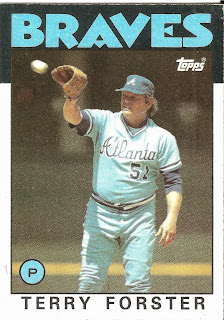Card
thoughts: Forster, who was once called a “Fat Tub
of Goo” by David Letterman, is certainly showing the weight in this picture.
The
player: Before being the most celebrated fat
man in baseball, Forster was a star closer (or “Fireman,” in the parlance of
today) for the White Sox. Unfortunately, both his weight, and wicked slider,
led to a myriad of injuries.
Forster came directly into the league from A-ball,
but at age 20, he saved 29 games. They
tried starting him in 1973, but he was back in the pen in 1974, with a league
leading 24 saves. Arm trouble in 1975 led to an almost year long haitus.
Further adding to his agonies, his brother was killed in a bar brawl in the off
season, with Forster present.
When Forster returned in 1976, he found that Rich
Gossage had supplanted him as the ace in the White Sox bullpen. The White Sox
decided to put him back in the rotation, where his 2-12 record led to him being
included with Rich Gossage in a trade to the Pirates. He was happy with the
trade, partly because he was reunited with former manager #351 Chuck Tanner,
and also because Forster was a good hitter and liked to swing the bat. He hit
.346 his first season with the Pirates, but he was still battling arm fatigue,
and was not much of a factor in his only season with the team.
A trade to the Dodgers improved his stock
dramatically. Always a better pitcher in a spacious, grass park, Forster saved
22 games with a 1.93 ERA in 1978. Unfortunately, two more years of ill-health
limited his effectiveness until 1982, when he pitched 83 innings and saved 3
games with an ERA just above 3.
The now portly Forster signed a big contract with
the Braves in the off season, and his first season with them was a good one, as
he saved 13 games with a 2.13 ERA. But Forster gained national notoriety when
David Letterman called him a “fat tub of goo” in his opening monologue. Instead
of getting angry, he went on Letterman and managed to one-up Dave on occasion
and be very
funny in his own right. Forster later sang the novelty
song “Fat is In,” which I can’t find anywhere online, which is lucky for you.
Despite all the self-deprecation, Forster was
concerned about his weight and slimmed down a bit after declaring free agency. He
actually was worse in 1986 after the weight loss, as his ERA “ballooned” to
3.51 with the Angels (his new team). But he didn’t get injured, at least
(although he did not appear in the post-season).
Still overweight, there was no uniform big enough
for Terry when he signed with the Twins AAA team in 1987. One had to be
specially shipped in from Milwaukee to cover his 260 pound frame.
A rarity among relievers, Forster hit an incredible
.397 in his career, which, believe it or not, is the highest career batting
average for a player with over 50 career at bats. In a typical self-deprecating
comment, he insisted many of the hits broke his bats, and were the result of good
luck.
Rear guard: 210 pounds? I don't think so (which goes to show the vitals are always from the players rookie year. Don't believe them!)


No comments:
Post a Comment